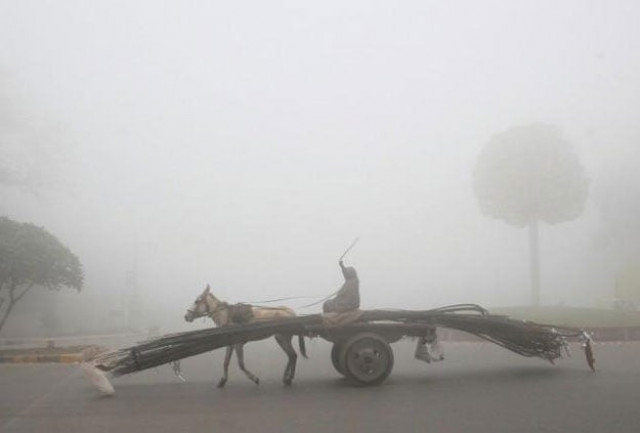Smog from India chokes Lahore
Sheikhupura, Faisalabad record highest pollution levels in province

Polluted air drifting in from India on Saturday caused deterioration of the air quality in central Punjab.
According to the Smog Monitoring and Early Warning System, Lahore's average Air Quality Index (AQI) over the next 24 hours is expected to remain between 220 and 240, a range considered very unhealthy for human health.
Environmental experts suspect that the pollution is driven by smoke originating from the industrial and agricultural regions of Ludhiana, Jalandhar, and Haryana. Crop residue burning in these areas has significantly increased PM2.5 and PM10 particulate levels, intensifying smog conditions across the region.
In the early morning, winds blowing at up to four miles per hour from the west and northwest temporarily improved air quality. However, as wind speeds dropped below two miles per hour around noon, pollutants began to accumulate again. By the evening, winds shifting to the east and southeast at four to six miles per hour pushed polluted air further into central Punjab.
Among the province's cities, Sheikhupura recorded the highest AQI at 257, followed by Faisalabad at 253 and Lahore at 241. Gujranwala recorded the AQI level of 208, Dera Ghazi Khan 167, Sargodha 151, Bahawalpur 143, Sialkot 139, Multan 132, and Rawalpindi 110.
The air quality readings within Lahore varied sharply across various monitoring stations. Safari Park registered an alarming 339, followed by Barki Road 322, Multan Road 298, Shahdara 220, GT Road 213, Kahna Nau 207, Punjab University 199, and DHA Phase VI 187.
In view of the situation, crackdowns are under way against brick kilns, factories, and vehicles emitting smoke. Field teams from the environment protection and forest departments remain on 24-hour duty and a zero-tolerance policy is being enforced against the burning of crop residues.
Authorities are also deploying anti-smog guns for water sprinkling and road cleaning in urban centres.
Sprinklers have also been installed at construction sites to minimise dust dispersion.
Officials say the introduction of super seeder equipment in agriculture has helped prevent stubble burning on farmland. Over 30 industrial units have been shifted to the long-delayed Sialkot Industrial Tannery Zone for reducing pollution.
The use of bailers to collect and repurpose crop residues is also gaining momentum. According to Senior Provincial Minister Mariyyum Aurangzeb, the government's top priorities include inter-district coordination, strict monitoring, and public participation to combat smog.
The environment protection department has urged citizens to avoid unnecessary outdoor exposure during morning and evening hours, wear masks and promptly report any incidents of stubble burning to local authorities.

























COMMENTS
Comments are moderated and generally will be posted if they are on-topic and not abusive.
For more information, please see our Comments FAQ